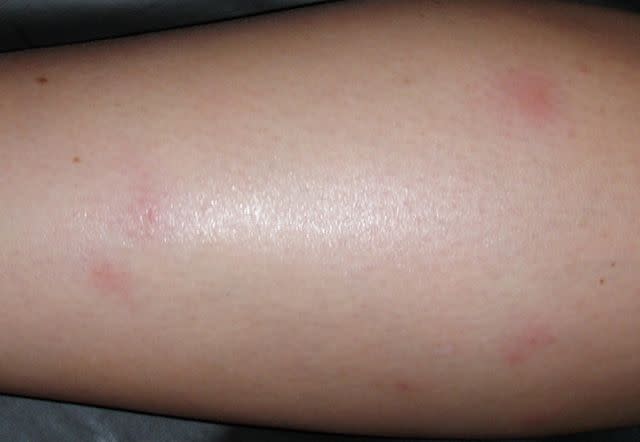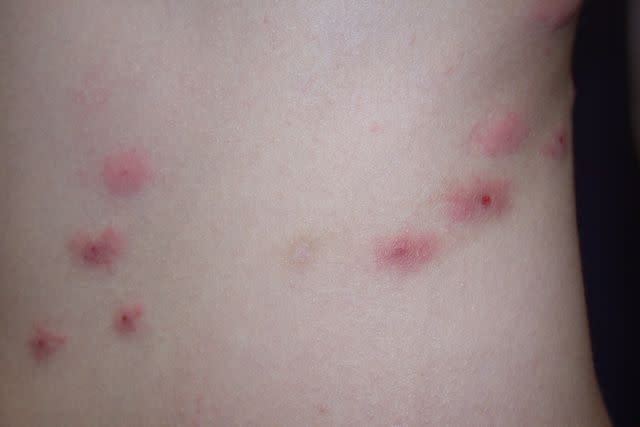Bedbug vs. Flea Bites: Which One Do I Have?
Medically reviewed by William Truswell, MD
If you have a new welt and suspect an insect bite, you may be wondering how to identify bedbug bites vs. fleabites.
Bedbug bites tend to occur in clusters of several bites in a jagged pattern. Bedbugs are active at night and tend to bite you while you sleep, so you may suspect bedbugs if you wake with bites. While fleabites also tend to occur in a pattern of three, they occur near the ankles and feet.
This article covers how to tell if you have bites from fleas or bedbugs, plus bite treatment and eradication tips.
Related: What Are Bedbugs?
Sensation: Bedbug Bites vs. Fleabites
Both bedbug bites and fleabites cause a similar sensation—they itch. Bedbugs cause itchy bumps. Similarly, fleabites cause itchy, small papules (a raised skin spot).
When bedbugs bite, they inject an anesthetic and anticoagulant that prevents you from feeling the bite while it occurs. However, later, bedbug bites are so itchy that they may cause you to lose sleep. In addition, excessive scratching may lead to a bacterial infection if you scratch open the skin.
Similarly, fleabites are so itchy that they can lead to infection from excessive scratching. In addition, fleabites and bedbug bites can both lead to papular urticaria, a hypersensitivity disorder that causes recurring hives that are hot and painful.
Spider, Ant, Bedbug, and Flea Bites
Spider, ant, bedbug, and flea bites share many common characteristics, including itching, rash, and sometimes pain. When you have a mystery bite, you may have to do some detective work to determine which may have caused your bite.
If your bite shows up after sleeping, bedbugs or spiders may be more likely since they are more prone to biting while you sleep.
Related: Signs and Symptoms of Bedbug Bites
Location and Size: Bedbug Bites vs. Fleabites
Bedbug bites typically appear on skin that is exposed while you sleep. That means bedbug bites often appear on the face, arms, and legs. They are similar in size to a hive or mosquito bite.
Fleabites, on the other hand, tend to appear on the feet and lower legs. That's because fleas often live in carpets and floorboards. Fleabites remain small and do not swell like a mosquito bite.
Appearance: Bedbug Bites vs. Fleabites
On human skin, bedbug bites appear in groups of three to five bites, often in a zigzag pattern. That's because once a bedbug finds a host to feed on, it probes the skin until it finds the best space to allow blood to flow most freely.

Reproduced with permission from © DermNet dermnetnz.org 2023.
Bed Bug BitesOnce it finds the best spot, a bedbug feeds for a few minutes before returning to its hiding place. Bites are generally red or pink and the size of a mosquito bite or smaller.
Fleabites look similar to bedbug bites on human skin but tend to be smaller. Like bedbug bites, they also generally form in a cluster or line because they mark the best spots to bite before they start feeding.

Reproduced with permission from © DermNet dermnetnz.org 2023.
Flea BitesThese bite clusters in fleas are known as the "breakfast, lunch, and dinner" pattern. Their meal might be interrupted by a host's movement or clothing friction, so they detach and find another nearby site to feed.
Related: How Bedbugs Are Diagnosed
Topical Treatment: Bedbug Bites vs. Fleabites
At-home treatment of bedbug bites and fleabites is to keep the bites clean and treat the itch. Common topical treatments include:
Antihistamine cream
Antibacterial ointment
To treat bedbug bites, dermatologists (doctors specializing in skin conditions) recommend cleaning the bites with soap and water to prevent infection and then applying an over-the-counter (OTC) corticosteroid for itching. Bedbug bites generally clear up within one to two weeks.
For fleabites, dermatologists similarly recommend keeping the bites clean and applying a topical anti-itch cream and antibacterial ointment to prevent infection.
A primary goal with bedbug and flea bites is to control the itch so you don't break open the skin and cause an infection. Things like oatmeal baths and tepid showers can help manage itching.
Eradication: Bedbug Bites vs. Fleabites
Treating the bites is only the beginning. Next, you will need to eradicate the source of the bedbug bites or fleabites. Hopefully, there will be clues to the cause of the bite, but sometimes you may need to investigate further.
Bedbug ID and Eradication
Look for signs of bedbugs near places where you and your family sleep—under mattresses, especially along mattress piping. You may have more luck if you do this at night with a flashlight. Signs of bedbugs include:
A sweet, musty odor
Specks of blood on mattresses and bedding
Exoskeletons (a bedbug's shed outer shell)
Bedbug poop (tiny, black specs)
Bugs and eggs
If you find evidence of an infestation, know that bedbug infestations are notoriously difficult to eradicate. For this reason, most people work with a professional. Regardless of if you treat yourself or use a pest control company, you will still need to follow the steps below:
Gather tools, such as a mattress cover, bedbug interceptors, a vacuum, caulk, a sponge and hot, soapy water, plastic bags, and bins.
Isolate and protect beds with mattress covers, cleaning, and bug collectors.
Clean and organize: Launder washable items in hot water and dry on high heat for at least 30 minutes. Place items that can't be washed in sealed plastic bags.
Vacuum everywhere, including along the walls, floorboards, and cracks and crevices.
Repair cracks in walls and floors and seal all openings where bedbugs could get in.
Throw away infested items, like upholstered furniture and small non-washable items.
Wash surfaces and furniture with hot, soapy water.
Steam clean mattresses and furniture.
Treat with insecticide.
Continue to inspect for bedbugs after treatment every seven days in case any eggs hatch in the meantime. Fumigation, either done yourself or by a professional, may also be performed. Viking gas is often used.
Flea ID and Eradication
Most often, fleas come into a home on pets. If you have pets, the quickest way to identify fleas is by carefully looking through your pet's fur for evidence. If you don't already, start your pet on flea prevention to keep fleas off your pet and out of your home.
Then, treat your home with the following steps:
Sanitize bedding, rugs, and your pet's bedding.
Bathe pets with soap and water, then comb with a flea comb.
Treat the home with insecticide, focusing on shady areas outside where pets spend the most time.
Repeat two or more times within five to 10 days to kill fleas in all stages of their life cycle.
Fumigation is easier to do yourself for fleas than it is for bedbugs. Proflex Encapsulated Solution and Duraflex CS are often used. As with bedbugs, fleas can be difficult to manage, so you may want to enlist the help of a professional.
Things That Invite Bedbugs and Fleas
The following may make your home more habitable for bedbugs and fleas:
Homes with many cracks and crevices for bugs to hide and breed
Homes with pets
Unvacuumed rugs and floors
Unwashed bedding
Recent travel
Tall grass around your home or where your pet spends time outdoors
Leaving pet food outside where flea-carrying rodents may frequent
Summary
Bedbug bites and fleabites share many qualities, including itching, rash, and bite patterns. But there are ways to tell them apart.
For example, bedbug bites may be slightly bigger (the size of a mosquito bite) and tend to occur on skin exposed at night, like the face, arms, and legs. On the other hand, fleabites are smaller and tend to appear on the ankles and feet.
If you have pets, fleas may be a more likely culprit. Both are challenging to eliminate, so you may want to enlist professional help.

